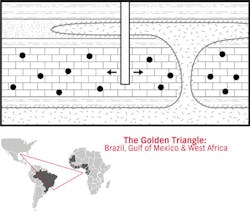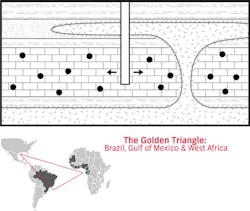Standardized equipment addresses drilling, well control issues
Julmar Shaun Toralde • Renato Borges • Lance Hopper • Roy Callison
Weatherford International
The massive hydrocarbon reserves of deepwater presalt reservoirs in oil’sGolden Triangle - the area between Brazil, West Africa, and the Gulf of Mexico - promise operators an economic windfall, provided they overcome some daunting drilling challenges first. The thick salt domes obscure the underlying reservoirs, which introduce significant uncertainty while drilling. In addition, the complex deviated entrances of most presalt reservoirs have narrow pore-pressure windows that raise the risk of kicks and losses when drilling with conventional methods.
Managed pressure drilling (MPD) techniques promise a solution to many of these drilling challenges. An adaptive drilling process used to precisely control the wellbore’s annular pressure profile, MPD employs an automated control system that detects minute pressure and flow changes and quickly adjusts surface backpressure to minimize the size of kicks or fluid losses. As a result, MPD brings an additional level of safety, efficiency, and productivity to the drilling operation, allowing the driller to reach target depth (TD) at reduced cost and risk.
But like many drilling advances before it, MPD is climbing a steep technology adoption curve in manydeepwater markets around the world. However, the drilling challenges in the Golden Triangle’s expansive presalt formations are compelling operators, drilling contractors, and service providers to quicken the pace of MPD technology integration on deepwater rigs working in pockets across this highly coveted real estate.
Structured for success
Weatherford has developed a comprehensive MPD support structure within the Golden Triangle that aims to help operators quickly cross the chasm between technology evaluation and full deployment. The service, which combines proprietary Weatherford technologies and international footprint with local personnel, facilities, and organizational support, can be rapidly ramped up or scaled back in response to changing market conditions.
Weatherford is working to implement a standardized set of MPD equipment that will allow a rig to quickly address any number of drilling and well control issues - kicks, lost circulation events or riser gas - whenever they might arise. Typical equipment include a rotating control device (RCD) to keep the well closed while diverting annular fluids out of the well; Microflux, an MPD control system used to detect and control minute downhole influxes and losses; a Coriolis mass-flow meter to capture mass and volume flow, mud weight/fluid density and temperature from returning annular fluids; hydraulic power units; and associated valves and hoses. An intelligent control unit and data acquisition system ties everything together by analyzing the system data, pinpointing the source and cause of a fluid influx or loss and transmitting the information to operation centers on location and onshore.
A standardized equipment offering avoids the need for building out a customized MPD system for each new well scenario, which would take the rig out of commission for many months for a retrofit. A flexible, fully integrated MPD system that is always ready on the rig gives the drilling contractor a competitive advantage when bidding on new drilling contracts.
Standardized MPD equipment also provides benefits in terms of consistent operating procedures, qualification testing, and troubleshooting. MPD equipment that is rigged up in essentially the same way on multiple rigs allows MPD specialists to transition to new rigs with ease and quickly gets to work on systems with which they are already familiar. Equipment servicing and maintenance can often be done right on the rig itself to minimize downtime. Some of the key points are discussed below.
Real-time collaboration. A major component of Weatherford’s comprehensive deepwater MPD service is the decision support center (DSC). This state-of-the-art facility contains an operations room for DSC support personnel, a conference room with video and teleconferencing capabilities, and a control room that houses multiple monitoring stations and displays streaming MPD data on as many as 24 individual drilling rigs. This MPD data, which is generated on site by the automated MPD control system, is then populated through the OneSync software platform, delivering seamless connectivity on the rig, in the office and across technologies, to effectively reduce risk and complexity while improving visibility and control.
Data accessible through the DSC enables onshore MPD teams - consisting of global technical support, project engineers, drilling advisors, local support personnel, and the client - to monitor and consult on many drilling programs, remotely and in real time. This is especially important during periods of high drilling activity when multiple rigs are working simultaneously.
In-country support. The MPD service employs nationals across the Golden Triangle in roles ranging from equipment logistics and installation to offshore maintenance and operational support and management. Each employee receives comprehensive training, both in the classroom and on the job, from experienced MPD support specialists who have successfully executed projects in other parts of the world.
To avoid the logistical delays associated with consistently bringing long lead-time equipment into and out of the different countries, the company has built massive repair and maintenance centers that are capable of providing all the servicing requirements of large deepwater MPD equipment in strategic locations in the Golden Triangle. The centers warehouse many of the parts used on MPD equipment, as well as critical back-up and spare parts, enabling maintenance and repair work to be completed quickly and with minimal downtime.
Proving its potential
The integrated MPD service has quickly paid dividends in several deepwater presalt wells. One operator deployed the service to explore the production potential of a P&A’d exploratory well that had been deemed undrillable by conventional practices. The previous drilling program recorded fluid losses of 60 b/hr (9.5 cu m/hr) upon encountering high-pressure loss zones. The MPD solution would enable drilling the well to TD while maintaining a constant bottomhole pressure (BHP) to effectively minimize the risk of losses and influxes.
Weatherford’s local MPD experts performed dynamic pore-pressure and formation-integrity tests to determine that the drilling window was 0.89 lb/gal (106.64 kg/cu m) through the loss zones. A drilling rig retrofitted with a suite of MPD equipment was deployed to reenter the well and drill to TD. The equipment included a Microflux control system and SeaShield Model 7875 below-tension-ring, slim RCD. These technologies worked in harmony to provide early kick and loss detection and then apply surface backpressure to enable precise control of BHP within the narrow drilling window.
Once a loss zone was detected, the cross-functional team comprising MPD technicians on the rig and engineering consultants at the onshore DSC worked together to adjust the wellbore pressure profile through commands sent to the control system. Even with a reduction in mud weight returns of 0.08 lb/gal (9.59 kg/cu m), the system maintained constant BHP and enabled drilling to continue without incurring nonproductive time.
The integrated MPD system helped land the well to its TD of approximately 21,325 ft (6,500 m), while transforming a previously abandoned well into a valuable asset with long-term production potential. The well accessed a 1,043-ft (318-m) reservoir containing API 31° oil.
Other deepwater regions
Since rolling out its integrated deepwater MPD service, Weatherford has successfully retrofitted more than a dozen drilling rigs for MPD operations in the Golden Triangle and is actively integrating MPD equipment into the construction process for new deepwater rigs. In order to accelerate rig integration of deepwater MPD systems, the company has also changed its business model from traditional rental to capital sales, transferring full ownership of the deepwater MPD equipment packages to the drilling contractor so that the equipment becomes part and parcel of their rig systems. The existing global footprint and support infrastructure of Weatherford for MPD systems allows it to continuously and consistently provide support services to these MPD-ready rigs, even if they are later deployed outside of the Golden Triangle.
The combined contribution of field-proven MPD equipment, in-country logistics and supply, highly trained nationals and access to real-time support specialists has trimmed rig retrofits down to a six-to-12-month timeframe, a significant improvement from the 12-plus months required for previous retrofits.
The integrated deepwater MPD service that Weatherford has deployed and continues to expand in the Golden Triangle serves as a model that can be easily replicated in other deepwater regions - bringing the industry closer to full adoption of a new drilling convention within which MPD is a standard option on every deepwater drilling rig.




